How to use the GEOMEAN function
What is the GEOMEAN function?
The GEOMEAN function lets you calculate the geometric mean in Excel. The geometric mean is a measure of the average rate of change.
Table of contents
1. Introduction
What is the difference between the geometric mean and the arithmetic mean (average)?
The geometric mean and arithmetic mean differ in how they are calculated. The geometric mean multiplies all the values together and then taking the n-th root, while the arithmetic mean adds all the values together and then divides by the number of values.
The AVERAGE function lets you calculate the arithmetic mean in Excel.
When to calculate the geometric mean?
The geometric mean is often a useful measure for data that increases or decreases rapidly like exponential or proportional numbers. The larger numbers skew the arithmetic mean while the geometric mean tends to better represent smaller values.
How is the geometric mean calculated?
It is calculated by multiplying the numbers together and then taking the nth root where n is the number of values.
For example, calculating the geometric mean from numbers 5 and 20 equals 10.
Here is how: 5*20 equals 100. The root of 100 is 10.
To calculate the geometric mean by hand use this formula:
GM - geometric mean
y1, y2, ..., yn - are the numbers
n is the number of values
2. Syntax
GEOMEAN(number1, [number2], ...)
3. Arguments
| Argument | Description |
| number1 | Required. A single numerical value or a cell reference to multiple numerical values. |
| [number2] | Optional. Upp to 254 additional arguments. |
Text, logical values and empty cells are ignored.
The GEOMEAN function returns
- #NUM! error value if number is less than or equal to 0 (zero).
4. Example
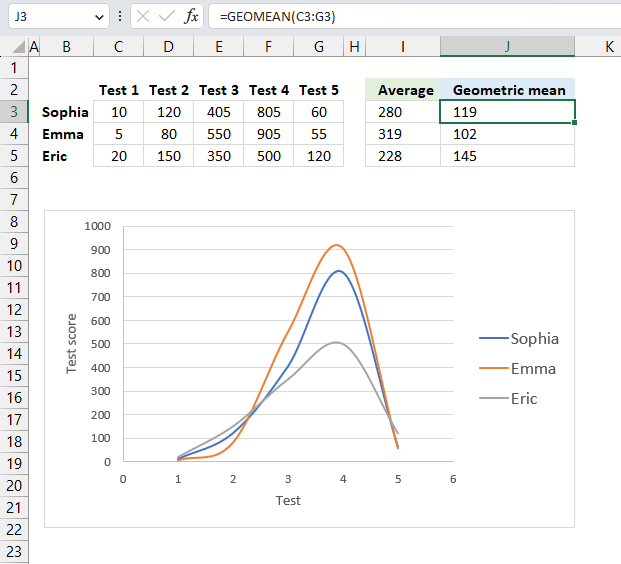
This example demonstrates how the geometric mean and the arithmetic mean can differ and show completely different results.
The image above shows five test scores for three students (Sophia, Emma, and Eric) in cells C3:G5, the arithmetic mean is calculated in cells I3:I5 and the geometric means are calculated in cells J3:J5.
Each test is equally important, however, tests 3 and 4 give much higher score than the other tests. How do we calculate an average test score that isn't distorted by test 3 and 4?
The arithmetic mean (average) tells us that Emma had the highest average test score. She had much better results in test 3 and 4, however, lower scores in test 1, 2, and 5 than the others. This shows that those tests (3 and 4) skew the arithmetic mean, the geometric mean is a better representation of the overall performance.
Formula in cell J3:
Eric has the highest geometric mean, he performed better than the other students in 3 out of 5 tests. In fact, Emma had the lowest geometric mean.
5. Sort rows based on geometric mean
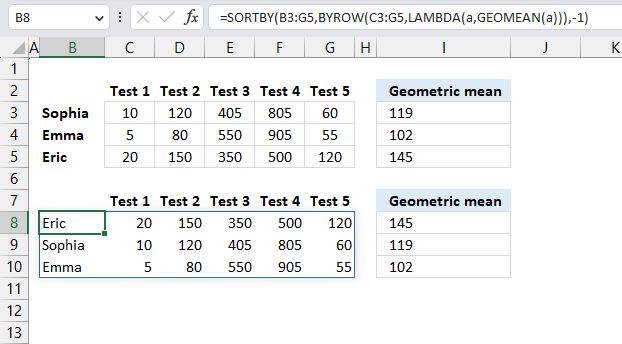
This example demonstrates an Excel 365 dynamic array formula in cell B8 that sorts rows in cell range B3:G5 based on the geometric mean values from large to small.
The image above shows a data table containing test scores for three students: Sophia, Emma and Eric. The geometric mean is calculated for each row in cells I3,I4, and I5 respectively.
| Test 1 | Test 2 | Test 3 | Test 4 | Test 5 | Geometric mean | ||
| Sophia | 10 | 120 | 405 | 805 | 60 | 119 | |
| Emma | 5 | 80 | 550 | 905 | 55 | 102 | |
| Eric | 20 | 150 | 350 | 500 | 120 | 145 |
The Excel 365 formula in cell B8 dynamically calculates the geometric mean for each student and returns a sorted list based the geometric mean. For example, Eric has the highest geometric mean score and his name, test scores and corresponding geometric mean is displayed in the first row.
The second highest score has Sophia and her name, test scores, and geometric mean is shown in the second row. The third highest score has Emma and here data is shown in the third row in the array output.
Excel 365 formula in cell B8:
The formula returns a dynamic array meaning it spills values to the right and to cells below as far as needed.
Explaining formula
Step 1 - Calculate geometric mean
The GEOMEAN function calculates the geometric mean.
Function syntax: GEOMEAN(number1, [number2], ...)
GEOMEAN(a)
Step 2 - Build the LAMBDA function
The LAMBDA function build custom functions without VBA, macros or javascript.
Function syntax: LAMBDA([parameter1, parameter2, …,] calculation)
LAMBDA(a,GEOMEAN(a))
Step 3 - Calculate geometric mean by row
The BYROW function puts values from an array into a LAMBDA function row-wise.
Function syntax: BYROW(array, lambda(array, calculation))
BYROW(C3:G5,LAMBDA(a,GEOMEAN(a)))
returns
{118.608736627981; 101.832590045365; 144.500087439159}
Step 4 - Sort rows based on geometric mean
The SORTBY function sorts a cell range or array based on values in a corresponding range or array.
Function syntax: SORTBY(array, by_array1, [sort_order1], [by_array2, sort_order2],…)
SORTBY(B3:G5,BYROW(C3:G5,LAMBDA(a,GEOMEAN(a))),-1)
becomes
SORTBY(B3:G5,{118.608736627981; 101.832590045365; 144.500087439159},-1)
and returns

6. Sort columns based on geometric mean
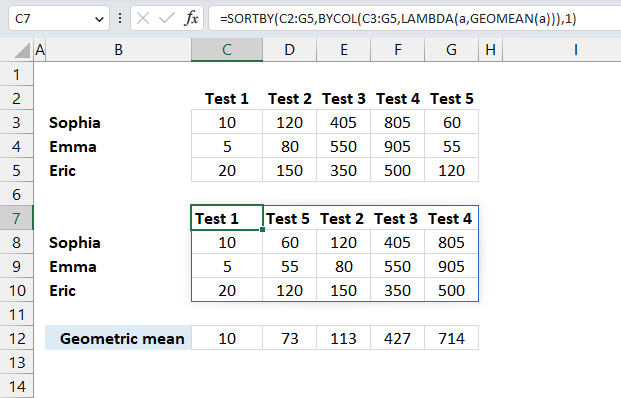
The image above shows an Excel 365 dynamic array formula in cell C7 that sorts columns in cell range C2:G5 based on the geometric mean values from small to large.
The image above shows a data table containing test scores for three students: Sophia, Emma and Eric. The geometric mean is calculated for each column in cells C12:G12 respectively.
| Test 1 | Test 2 | Test 3 | Test 4 | Test 5 | |
| Sophia | 10 | 120 | 405 | 805 | 60 |
| Emma | 5 | 80 | 550 | 905 | 55 |
| Eric | 20 | 150 | 350 | 500 | 120 |
The Excel 365 formula in cell C7 dynamically calculates the geometric mean for each test and returns a sorted list based on the geometric mean from small to large. For example, Test 1 has the lowest geometric mean score and is displayed in the first column. Test 5 is the second column meaning it has the second smallest geometric mean score etc.
Excel 365 formula in cell C7:
The formula returns a dynamic array meaning it spills values to the right and to cells below as far as needed.
Explaining formula
Step 1 - Calculate geometric mean
The GEOMEAN function calculates the geometric mean.
Function syntax: GEOMEAN(number1, [number2], ...)
GEOMEAN(a)
Step 2 - Build the LAMBDA function
The LAMBDA function build custom functions without VBA, macros or javascript.
Function syntax: LAMBDA([parameter1, parameter2, …,] calculation)
LAMBDA(a,GEOMEAN(a))
Step 3 - Calculate geometric mean by column
The BYCOL function passes all values in a column based on an array to a LAMBDA function, the LAMBDA function calculates new values based on a formula you specify.
Function syntax: BYCOL(array, lambda(array, calculation))
BYCOL(C3:G5,LAMBDA(a,GEOMEAN(a)))
returns
{10,112.924323465723,427.19738509951,714.175292454516,73.4342046204996}
Step 4 - Sort rows based on geometric mean
The SORTBY function sorts a cell range or array based on values in a corresponding range or array.
Function syntax: SORTBY(array, by_array1, [sort_order1], [by_array2, sort_order2],…)
SORTBY(B3:G5,BYCOL(C3:G5,LAMBDA(a,GEOMEAN(a))),1)
becomes
SORTBY(B3:G5,{10,112.924323465723,427.19738509951,714.175292454516,73.4342046204996},1)
and returns
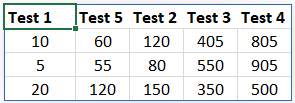
7. Function not working

GEOMEAN function returns the #NUM! error value if any data point is less than or equal to 0 (zero).
7.1 Troubleshooting the error value

When you encounter an error value in a cell a warning symbol appears, displayed in the image above. Press with mouse on it to see a pop-up menu that lets you get more information about the error.
- The first line describes the error if you press with left mouse button on it.
- The second line opens a pane that explains the error in greater detail.
- The third line takes you to the "Evaluate Formula" tool, a dialog box appears allowing you to examine the formula in greater detail.
- This line lets you ignore the error value meaning the warning icon disappears, however, the error is still in the cell.
- The fifth line lets you edit the formula in the Formula bar.
- The sixth line opens the Excel settings so you can adjust the Error Checking Options.
Here are a few of the most common Excel errors you may encounter.
#NULL error - This error occurs most often if you by mistake use a space character in a formula where it shouldn't be. Excel interprets a space character as an intersection operator. If the ranges don't intersect an #NULL error is returned. The #NULL! error occurs when a formula attempts to calculate the intersection of two ranges that do not actually intersect. This can happen when the wrong range operator is used in the formula, or when the intersection operator (represented by a space character) is used between two ranges that do not overlap. To fix this error double check that the ranges referenced in the formula that use the intersection operator actually have cells in common.
#SPILL error - The #SPILL! error occurs only in version Excel 365 and is caused by a dynamic array being to large, meaning there are cells below and/or to the right that are not empty. This prevents the dynamic array formula expanding into new empty cells.
#DIV/0 error - This error happens if you try to divide a number by 0 (zero) or a value that equates to zero which is not possible mathematically.
#VALUE error - The #VALUE error occurs when a formula has a value that is of the wrong data type. Such as text where a number is expected or when dates are evaluated as text.
#REF error - The #REF error happens when a cell reference is invalid. This can happen if a cell is deleted that is referenced by a formula.
#NAME error - The #NAME error happens if you misspelled a function or a named range.
#NUM error - The #NUM error shows up when you try to use invalid numeric values in formulas, like square root of a negative number.
#N/A error - The #N/A error happens when a value is not available for a formula or found in a given cell range, for example in the VLOOKUP or MATCH functions.
#GETTING_DATA error - The #GETTING_DATA error shows while external sources are loading, this can indicate a delay in fetching the data or that the external source is unavailable right now.
7.2 The formula returns an unexpected value

To understand why a formula returns an unexpected value we need to examine the calculations steps in detail. Luckily, Excel has a tool that is really handy in these situations. Here is how to troubleshoot a formula:
- Select the cell containing the formula you want to examine in detail.
- Go to tab “Formulas” on the ribbon.
- Press with left mouse button on "Evaluate Formula" button. A dialog box appears.
The formula appears in a white field inside the dialog box. Underlined expressions are calculations being processed in the next step. The italicized expression is the most recent result. The buttons at the bottom of the dialog box allows you to evaluate the formula in smaller calculations which you control. - Press with left mouse button on the "Evaluate" button located at the bottom of the dialog box to process the underlined expression.
- Repeat pressing the "Evaluate" button until you have seen all calculations step by step. This allows you to examine the formula in greater detail and hopefully find the culprit.
- Press "Close" button to dismiss the dialog box.

There is also another way to debug formulas using the function key F9. F9 is especially useful if you have a feeling that a specific part of the formula is the issue, this makes it faster than the "Evaluate Formula" tool since you don't need to go through all calculations to find the issue..
- Enter Edit mode: Double-press with left mouse button on the cell or press F2 to enter Edit mode for the formula.
- Select part of the formula: Highlight the specific part of the formula you want to evaluate. You can select and evaluate any part of the formula that could work as a standalone formula.
- Press F9: This will calculate and display the result of just that selected portion.
- Evaluate step-by-step: You can select and evaluate different parts of the formula to see intermediate results.
- Check for errors: This allows you to pinpoint which part of a complex formula may be causing an error.
The image above shows cell reference B3:B10 converted to hard-coded value using the F9 key. The GEOMEAN function requires data points larger than 0 (zero) which is not the case in this example. We have found what is wrong with the formula.
Tips!
- View actual values: Selecting a cell reference and pressing F9 will show the actual values in those cells.
- Exit safely: Press Esc to exit Edit mode without changing the formula. Don't press Enter, as that would replace the formula part with the calculated value.
- Full recalculation: Pressing F9 outside of Edit mode will recalculate all formulas in the workbook.
Remember to be careful not to accidentally overwrite parts of your formula when using F9. Always exit with Esc rather than Enter to preserve the original formula. However, if you make a mistake overwriting the formula it is not the end of the world. You can “undo” the action by pressing keyboard shortcut keys CTRL + z or pressing the “Undo” button
7.3 Other errors
Floating-point arithmetic may give inaccurate results in Excel - Article
Floating-point errors are usually very small, often beyond the 15th decimal place, and in most cases don't affect calculations significantly.
Functions in 'Statistical' category
The GEOMEAN function function is one of 73 functions in the 'Statistical' category.
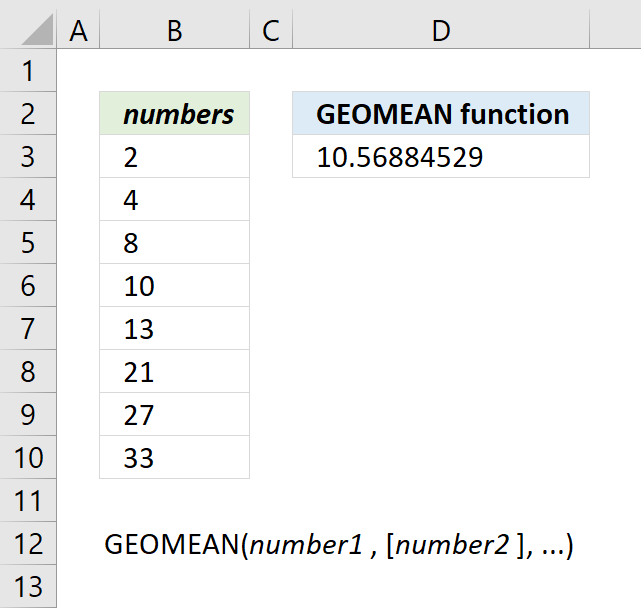
How to comment
How to add a formula to your comment
<code>Insert your formula here.</code>
Convert less than and larger than signs
Use html character entities instead of less than and larger than signs.
< becomes < and > becomes >
How to add VBA code to your comment
[vb 1="vbnet" language=","]
Put your VBA code here.
[/vb]
How to add a picture to your comment:
Upload picture to postimage.org or imgur
Paste image link to your comment.
Contact Oscar
You can contact me through this contact form